|
Posted on 01/07/2004 12:00:20 AM PST by SAMWolf
|
|
 are acknowledged, affirmed and commemorated.
|

| Our Mission: The FReeper Foxhole is dedicated to Veterans of our Nation's military forces and to others who are affected in their relationships with Veterans.
Where the Freeper Foxhole introduces a different veteran each Wednesday. The "ordinary" Soldier, Sailor, Airman or Marine who participated in the events in our Country's history. We hope to present events as seen through their eyes. To give you a glimpse into the life of those who sacrificed for all of us - Our Veterans.
|
|
A1C John Levitow had only seconds to save the lives of eight crewmen aboard the battle-damaged gunship.  Airman First Class John L. Levitow On operational missions, Loadmaster Levitow was responsible, among other duties, for setting the ejection and ignition controls of the Mark-24 magnesium flares carried by USAF gunships in Southeast Asia. The flares provided illumination for troops on the ground, for the gunship's pilot to aim his three side-firing 7.62-mm Miniguns, and for fighters that might be called in to help suppress enemy fire. Once the controls were set, the Mark-24, packed in a three-foot long metal tube weighing about 27 pounds, was passed to a gunner who triggered the arming mechanism and who tossed the tube out the plane's cargo door. Ten seconds after release, an explosive charge opened the flare's parachute, and in another 10 seconds the magnesium ignited, generating a light of 2,000,000 candlepower. At 4,000 degrees Fahrenheit, the flare could burn through metal. The Mark-24 was not to be treated casually. Improperly handled, it could be painfully lethal.  The AC-47, Spooky 71, that John L. Levitow saved from disaster On that February night, Spooky 71 had been in the air for four and a half hours when Maj. Kenneth Carpenter, the aircraft commander, was directed to an area south of the Army base where enemy mortars were laying down a heavy barrage. As the plane arrived at its target area, Levitow handed a flare to Amn. Ellis Owen, whose finger was through the safety pin ring preparatory to tossing the flare through the door at Carpenter's command. Suddenly Spooky 71 was rocked by a tremendous blast. An 82-mm mortar shell had exploded inside the gunship's right wing, showering the cargo compartment with shrapnel. All five crew members in the rear of the plane were hurled to the floor, bleeding from shrapnel wounds. Spooky 71 fell into a steep, descending turn to the right, momentarily out of control. The flare, torn from Owen's hands by the blast, rolled around the aircraft floor fully armed amidst several thousand rounds of live ammunition for the Miniguns.  Through a haze of pain and shock, Levitow, with 40 shrapnel wounds in his legs, side, and back, saw one of the crew lying perilously close to the open cargo door. As he dragged the wounded man to safety, Levitow spied the armed, smoking flare rolling erratically around the cargo compartment. How long had it been since the safety pin was pulled inadvertently--five seconds? Fifteen seconds? Levitow had no way of knowing. He did know that the timing mechanism could have been damaged, which might result in premature ignition. In a matter of seconds the flare would ignite, its intense heat turning the stricken gunship into an inferno. Navigator William Platt later said the plane was "lit up like daylight."  Sgt. Edward Fuzie, wounded in the blast, watched three men be knocked over by the impact, one covered with blood. Levitow, who mistakenly believed that the AC-47's machine gun had exploded was hit by shrapnel that "felt like a two-by-four." He knew something traumatic had severely damaged the plane but was unsure what.  Carpenter learned over the intercom that everyone in the back of Spooky 71 was wounded and that there was a new mortal danger — a loose, burning Mark 24 magnesium flare had been knocked free in the fuselage and was rolling amid ammunition cans, which contained 19,000 rounds of live ammo. In less than 20 seconds the AC-47 would become a blazing torch. Levitow had no way to know how many seconds remained on the flare's fuse. Weak from the loss of blood and numb from 40 wounds on his right side, Levitow realized that he was closest to the flare. With others seriously wounded, there was no way the crew could bail out.  Weakened from loss of blood and partially paralyzed by his wounds, Levitow tried vainly to pick up the flare as it skidded around the floor. Seconds ticked by. Finally, in desperation, he threw himself on the flare, dragged it to the open door, a trail of blood marking his path, and pushed it out just as it ignited in a white-hot blaze. Levitow then lapsed into unconsciousness. As recounted in the Air Force's official history, Carpenter remembered, "The aircraft [was] in a 30-degree bank and how Levitow ever managed to get to the flare and throw it out, I'll never know."  Carpenter managed to regain control of the gunship, its wings and fuselage riddled by 3,500 shrapnel holes, one of them three feet in diameter. Ambulances and a medical evacuation helicopter were waiting on the flight line at Bien Hoa, Spooky 71's home base, when the battered plane landed with its five injured crewmen--two of them, including John Levitow, seriously wounded. Levitow was flown to a hospital in Japan. After he recovered, he flew 20 more combat missions before returning to the States to complete his enlistment as a C-141 loadmaster at Norton AFB, Calif. On Armed Forces Day, May 14, 1970, President Nixon presented the Medal of Honor to Levitow in a ceremony at the White House. The young airman's heroism in the night sky over Vietnam had added another chapter to the saga of valor that is a vital element of the Air Force heritage.  Airman First Class John L. Levitow's Medal of Honor Citation: For conspicuous gallantry and intrepidity in action at the risk of his life above and beyond the call of duty. Sgt. Levitiow (then A1C), U.S. Air Force, distinguished himself by exceptional heroism while assigned as a loadmaster aboard an AC-47 aircraft flying a night mission in support of Long Binh Army Post. Sgt. Levitow's aircraft was struck by a hostile mortar round. The resulting explosion ripped a hole 2 feet in diameter through the wing and fragments made over 3,500 holes in the fuselage. All occupants of the cargo compartment were wounded and helplessly slammed against the floor and fuselage. The explosion tore an activated flare from the grasp of a crewmember who had been launching flares to provide illumination for Army ground troops engaged in combat. Sgt. Levitow, though stunned by the concussion of the blast and suffering from over 40 fragment wounds in the back and legs, staggered to his feet and turned to assist the man nearest to him who had been knocked down and was bleeding heavily. As he was moving his wounded comrade forward and away from the opened cargo compartment door, he saw the smoking flare ahead of him in the aisle. Realizing the danger involved and completely disregarding his own wounds, Sgt. Levitow started toward the burning flare. The aircraft was partially out of control and the flare was rolling wildly from side to side. Sgt. Levitow struggled forward despite the loss of blood from his many wounds and the partial loss of feeling in his right leg. Unable to grasp the rolling flare with his hands, he threw himself bodily upon the burning flare. Hugging the deadly device to his body, he dragged himself back to the rear of the aircraft and hurled the flare through the open cargo door. At that instant the flare separated and ignited in the air, but clear of the aircraft. Sgt. Levitow, by his selfless and heroic actions, saved the aircraft and its entire crew from certain death and destruction. Sgt. Levitow's gallantry, his profound concern for his fellowmen, at the risk of his life above and beyond the call of duty are in keeping with the highest traditions of the US Air Force and reflect great credit upon himself and the Armed Forces of his country.
|
I offer apologies for the "super size" of this post for those who are on dialup connections.
|
Air Power |
In South Vietnam, the airplane once again entered combat, this time in a ground support role as AC-119 "gunships" mounting side-firing weapons capable of firing up to 6,000 rounds per minute per gun. The Air Force enhanced its close air support (CAS) capability during the Vietnam War by converting C-47, C-119, and C-130 transports into heavily armed AC-47, AC-119, and AC-130 ground-support aircraft. The Special Air Warfare Center's 1st Combat Applications Group accomplished literally thousands of projects between 1962 and 1972. These ranged from testing the prototype VC-123 transport under field conditions to designing an efficient dispenser for sterile screwworm flies. The 1st CAG developed low-light television equipment for night strikes and reconnaissance, as well as cargo extraction systems. It also tested the AC-47, AC-119, and AC-130 gunship platforms.
In 1967, Fairchild converted 52 C-119G aircraft into gunships for use in South Vietnam with one-half being AC-119G Shadows and the other 26 AC-119K Stingers. Both ground support aircraft had four 7.62 mm miniguns and, in addition, the Stinger received two 20 mm rotary cannons. The AC-119K had upgraded radar, communications and navigation systems and two J85 engines for jet-assisted takeoff.
The Air Force phased out its last AC-119 in 1973
Specifications:
Manufacturer: Fairchild
Primary Role: Cargo, the upgraded to a CAS Gunship.
Engines: 2 Pratt & Whitney R-4360-20 with 3500 Horsepower 3500 each
Dimensions:
Wing span: 109 feet 3 inches
Length: 86 feet 5 inches
Height: 26 feet 7 inches
Wing area: 1447.00 Sq Ft
Weights: Empty 39800.0 lbs - Max 74000.0 lbs
Performance :
Range: 1770 miles
Max Speed: 281.00 Mph 244.32 Knots
Climb: 1010.00 Ft/min
Ceiling: 23900.0 Ft
Armaments:
C-119G: Four 7.62 miniguns
C-119K: Four 7.62 minguns and two 20MM Rotary cannons.

|
Air Power |
The AC-130H Spectre gunship's primary missions are close air support, air interdiction and armed reconnaissance. Other missions include perimeter and point defense, escort, landing, drop and extraction zone support, forward air control, limited command and control, and combat search and rescue.
These heavily armed aircraft incorporate side-firing weapons integrated with sophisticated sensor, navigation and fire control systems to provide surgical firepower or area saturation during extended periods, at night and in adverse weather.
During Vietnam, gunships destroyed more than 10,000 trucks and were credited with many life-saving close air support missions. AC-130s suppressed enemy air defense systems and attacked ground forces during Operation Urgent Fury in Grenada. This enabled the successful assault of Point Salines airfield via airdrop and airland of friendly forces.
The gunships had a primary role during Operation Just Cause in Panama by destroying Panamanian Defense Force Headquarters and numerous command and control facilities by surgical employment of ordnance in an urban environment. As the only close air support platform in the theater, Spectres were credited with saving the lives of many friendly personnel.
During Operation Desert Storm, Spectres provided air base defense and close air support for ground forces. AC-130s were also used during Operations Continue Hope and United Shield in Somalia, providing close air support for United Nations ground forces. The gunships have most recently played a pivotal role during operations in support of the NATO mission in Bosnia-Herzegovina, providing air interdiction against key targets in the Sarajevo area.
The AC-130 is an excellent fire support platform with outstanding capabilities. With its extremely accurate fire control system, the AC-130 can place 105mm, 40mm and 25mm munitions on target with first round accuracy. The crew of these aircraft are extremely proficient working in military operations in urban terrain [MOUT] environments.
The Air Force commemorated the end of an era 10 September 1995 with the retirement of the first C-130 aircraft to come off a production line. The aircraft, tail number 53-3129, went into production at the Lockheed Aircraft Co. in Marietta, Ga., in 1953 and was the original prototype of what was to become a long line of C-130 Hercules aircraft designed and built by Lockheed. The aircraft, affectionately dubbed "The First Lady," was one of five AC-130A gunship aircraft retired during an official ceremony. While the other four aircraft were sent to the Aerospace Marketing and Regeneration Center at Davis-Monthan Air Force Base, the First Lady went on permanent display at the Eglin Air Force Base Armament Museum. The 919th Special Operations Wing's gunships, all around 40 years old, had reached the age of mandatory retirement. The only other gunships in the Air Force inventory are employed by active-duty members at Hurlburt Field, which has less than 20 gunships assigned.
The AC-130H ALQ-172 ECM Upgrade installs and modifies the ALQ-172 with low band jamming capability for all AC-130H aircraft. It also modifies the ALQ-172 with engineering change proposal-93 to provide increased memory and flight line reprogramming capabilities. The Air Force [WR-ALC/LUKA] issued a sole source, fixed price contract, to International Telephone & Telegraph (ITT) for development of low band jammer and subsequent production. Issue a competitive, firm fixed price contract for the Group A modifications (preparing aircraft to receive jammers).
Currently funded weight reduction and center of gravity (CG) improvements to the AC-130H aircraft include: redesign of 40mm and 105mm ammo racks using lighter weight materials; reverse engineering of 40mm and 105mm trainable gun mounts using lighter weight material; and removal of non-critical armor. These efforts are performed by a sole source contract awarded to Rock Island Arsenal.
AC-130U Spooky
Continuing the distinguished combat history of side-firing AC-130 gunships, the new AC-130U Spectre gunship is being fielded as a replacement for the AC-130A aircraft. This program acquires 13 new basic C-130H aircraft for modification and integration by Boeing to the AC-130U Gunship configuration. The AC-130U gunship airframe is integrated with an armor protection system (APS), high resolution sensors (All Light Level Television (ALLTV), infrared detection set (IDS) and strike radar), avionics and EW systems, a sophisticated software controlled fire control system, and an armament suite consisting of side-firing, trainable 25mm, 40mm, and 105mm guns. The strike radar provides the first gunship capability for all weather/night target acquisition and strike. The acquisition program for this new gunship evolved from a Congressional mandate in the mid-1980s to revitalize the special operations force capabilties. Following the contract award to Rockwell in July 1987, the aircraft was first flown on 20 December 1990. FY92 procurement funding was increased to provide the 13th aircraft to replace the AC-130H lost during Desert Storm. Upon completing an exhaustive flight test program at Air Force Flight Test Center from 1991 to 1994 the first aircraft was delivered to AFSOC on July 1, 1994. Boeing’s contract includes: concurrent development, aircraft production, flight test, and delivery. All aircraft have been delivered and the program is transitioning to the sustainment phase. A competitive contract for sustainment was awarded in July 1998.
The AC-130U is the most complex aircraft weapon system in the world today. It has more than 609,000 lines of software code in its mission computers and avionics systems. The newest addition to the command fleet, this heavily armed aircraft incorporates side-firing weapons integrated with sophisticated sensor, navigation and fire control systems to provide surgical firepower or area saturation during extended loiter periods, at night and in adverse weather. The sensor suite consists of an All Light Level Television system and an infrared detection set. A multi-mode strike radar provides extreme long-range target detection and identification. It is able to track 40mm and 105mm projectiles and return pinpoint impact locations to the crew for subsequent adjustment to the target. The fire control system offers a Dual Target Attack capability, whereby two targets up to one kilometer apart can be simultaneously engaged by two different sensors, using two different guns. No other air-ground attack platform in the world offers this capability. Navigational devices include the inertial navigation system (INS) and global positioning system (GPS). The aircraft is pressurized, enabling it to fly at higher altitudes, saving fuel and time, and allowing for greater range than the AC-130H. Defensive systems include a countermeasures dispensing system that releases chaff and flares to counter radar infrared-guided anti-aircraft missiles. Also infrared heat shields mounted underneath the engines disperse and hide engine heat sources from infrared-guided anti-aircraft missiles.
The AC-130U P3I program develops and procures modifications that correct software and hardware deficiencies of the AC-130U fleet discovered during flight tests and that were outside the scope of the original FY86 contract. These modifications will include the following: combine all necessary software requirements for the System Integration Test (SIT) system and hardware and software improvements for the APQ-180 strike radar system; upgrade the Tactical Situation Map; improve core avionics and computers required for the multi-mission advanced tactical terminal/integrated defense avionics system installation; upgrade the EW suite; and modify the software/hardware required for the trainable gun mounts.
The AC-130H/U, AAQ-26 Infrared Detection Set (IDS) Upgrade program modifies the optics on the AN/AAQ-17 Infrared Detection Set (IDS) currently installed on 13 AC-130U and 8 AC-130H Gunship aircraft to the AN/AAQ-26 configuration. The AC-130U wiring, Operational Flight Program (OFP), Control Displays Program (CDP), Trackhandle, bus multiplier (BMUX), control panels, and variable slow rate feature will be modified. The AC-130H will also be modified. Support equipment, spares, and tech data for both aircraft will be modified as required to support the AN/AAQ-26 configuration. Mission requirements dictate a significant enhancement in target detection, recognition, and identification ranges to decrease aircraft vulnerability. A sole source fixed price incentive contract was awared to Raytheon for design, modification, and installation; with directed sub to Lockheed Aerospace Systems Ontario (LASO) for integration of the AN/AAQ-26 on the AC-130H and Rockwell for software integration of the AN/AAQ-26 on the AC-130U.
The United States Special Operations Command (USSOCOM) has a requirement for a C-130 engine infrared (IR) signature suppression system to provide Special Operations Forces (SOF) C-130 aircraft with an IR signature reduction equal to or better than existing systems at a lower cost of ownership. The primary difficulties with present suppressor systems are low reliability and poor maintainability. This C-130 Engine Infrared Suppression (EIRS) Program system will be used on AC-130H/U, MC-130E/H/P, and EC-130E aircraft. The key requirements for the Engine IR Suppression system are: (a) improved reliability and maintainability over existing systems to result in lower total cost of ownership; (b) IR signature suppression levels as good as the current engine shield system (aka. Tubs); (c) no adverse impacts to aircraft performance and ability to accomplish SOF missions; (d) complete interchangeability between engine positions and identified aircraft types. The suppressor is expected to be a semi-permanent installation, with removal being primarily for servicing, allowing the aircraft to perform all required missions with the suppressors installed. There will be up to two competitive contracts awarded for the initial phases of development with a downselect to one contractor for the completion of development and production. The contract will contain fixed price options for procurement, installation, and sustainment of the system.
The Directional Infrared Countermeasures (DIRCM) program develops and procures 60 systems and provides 59 SOF aircraft (AC-130H/U, MC-130E/H) with a DIRCM system capability. The DIRCM system will work in conjunction with other onboard self-protection systems to enhance the aircraft’s survivability against currently deployed infrared guided missiles. Growth is planned to add a capability to detect and counter advanced threats. Execution of this program is in concert with a joint US/UK cooperative development/ production effort with the UK as lead. Development and acquisition of the DIRCM system will be in accordance with UK procurement laws/regulations. UK designation for this program is "Operational Emergency Requirements 3/89."
Specifications |
||||
| AC-130H Spectre | AC-130U Spooky | |||
| Primary Function: | Close air support, air interdiction and armed reconnaissance |
|||
| Contractor: | Lockheed Aircraft Corp. | |||
| Power Plant: | Four Allison turboprop engines T56-A-15 | |||
| Thrust: | Each engine 4,910 horsepower | |||
| Length: | 97 feet, 9 inches (29.8 meters) | |||
| Height: | 38 feet, 6 inches (11.7 meters) | |||
| Maximum Takeoff Weight: | 155,000 pounds (69,750 kilograms) | |||
| Wingspan: | 132 feet, 7 inches (40.4 meters) | |||
| Range: | 1,500 statute miles (1,300 nautical miles) Unlimited with air refueling |
2,200 nautical miles Unlimited with air refueling |
||
| Ceiling: | 25,000 feet (7,576 meters) | 30,000 ft. | ||
| Speed: | 300 mph (Mach 0.40) (at sea level) | |||
| Armament: | two M61 20mm Vulcan cannons with 3,000 rounds one L60 40mm Bofors cannon with 256 rounds one M102 105mm howitzer with 100 rounds |
One 25mm GAU-12 Gatling gun (1,800 rounds per minute) one L60 40mm Bofors cannon (100 shots per minute) one M102 105mm cannon (6-10 rounds per minute) |
||
| Countermeasures |
|
|||
| Crew: | 14 -- five officers (pilot, co-pilot, navigator, fire control officer, electronic warfare officer); nine enlisted (flight engineer, loadmaster, low-light TV operator, infrared detection set operator, five aerial gunners) | 13 total. Five officers (pilot, copilot, navigator, fire control officer, electronic warfare officer); 8 enlisted (flight engineer, All Light Level TV operator, infrared- detection set operator, four airborne gunners, loadmaster) | ||
| Unit Cost: | $46.4 million (1992 dollars) | $72 million | ||
| Date Deployed: | 1972 | 1995 | ||
| Inventory: | Active force, 8; Reserve, 0; ANG, 0 |
13 aircraft assigned to 16th Special Operation Wing's 4th Special Operations Squadron. | ||

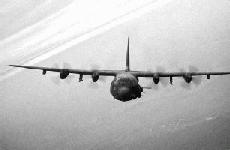
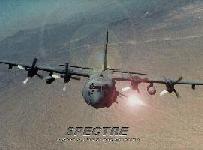
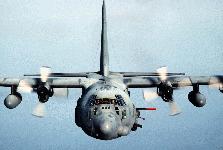
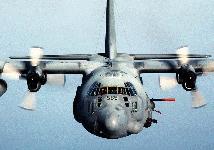
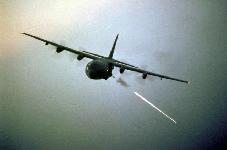
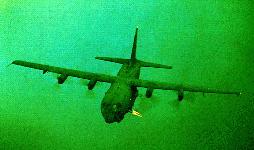

A Republic, if you can keep her.
1968 Surveyor 7 lands on the Moon
The meek can have the Earth. I want the stars.
LOL. Yep.
LOL. I hadn't thought of it that way. Me too!
Disclaimer: Opinions posted on Free Republic are those of the individual posters and do not necessarily represent the opinion of Free Republic or its management. All materials posted herein are protected by copyright law and the exemption for fair use of copyrighted works.